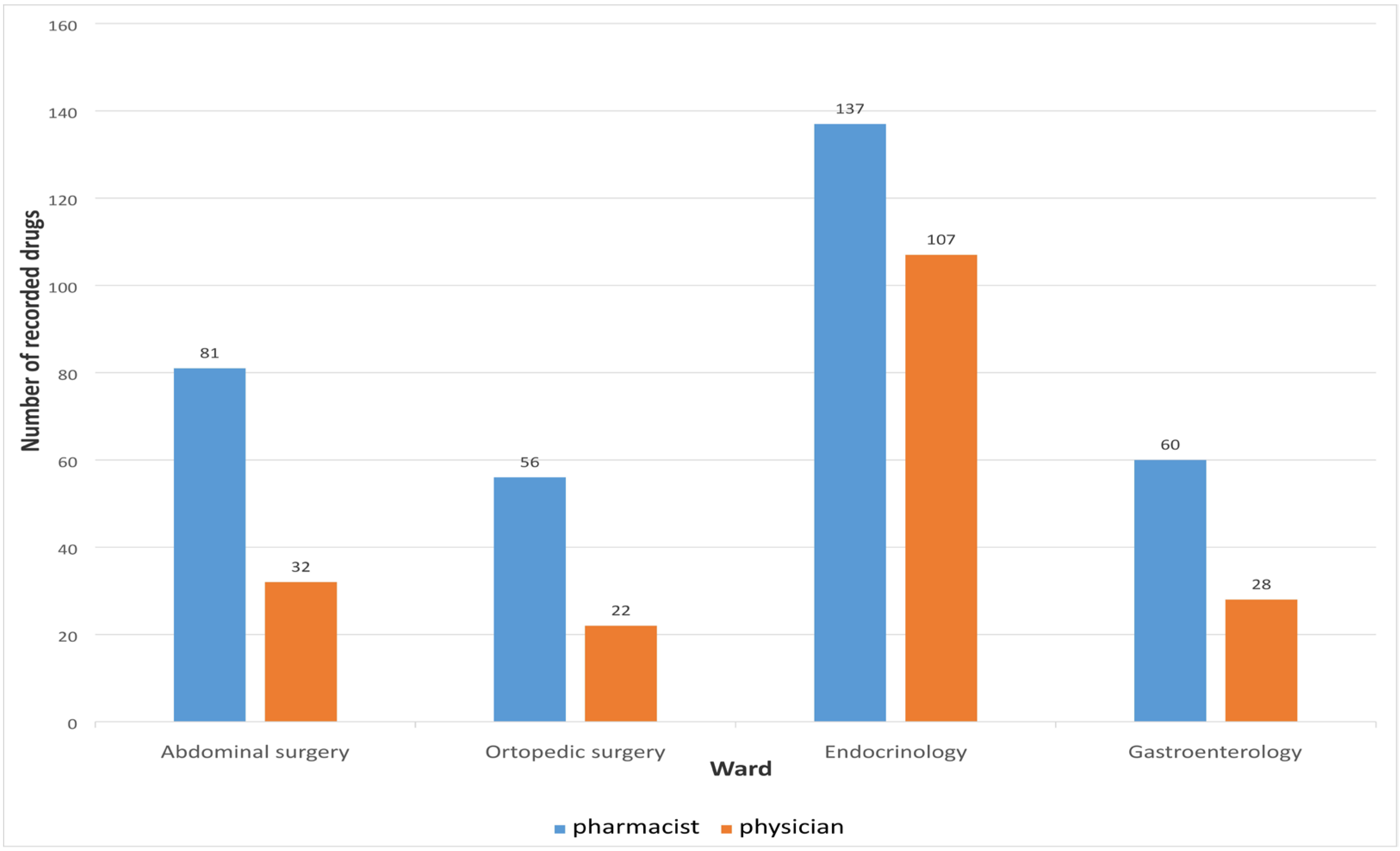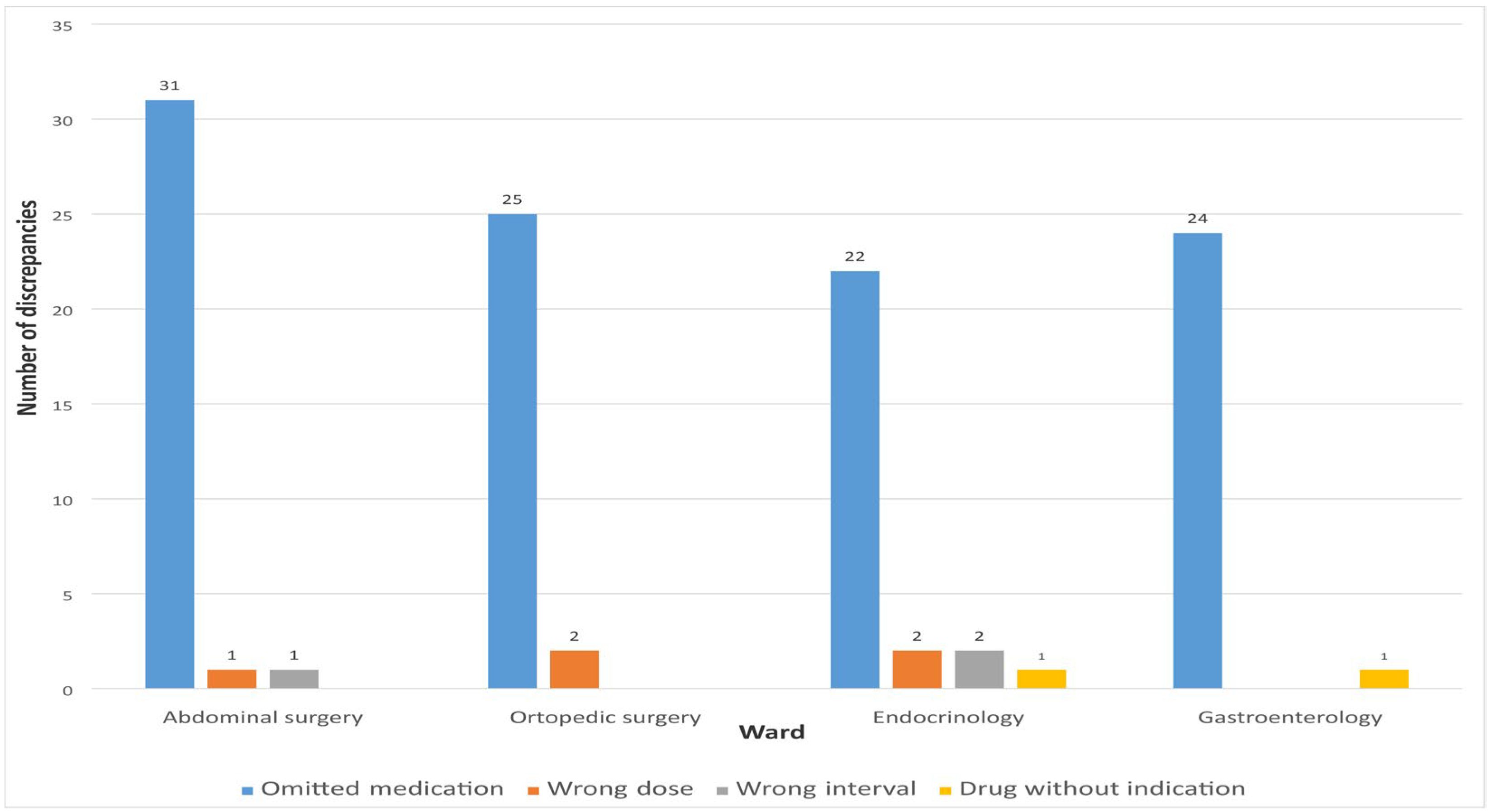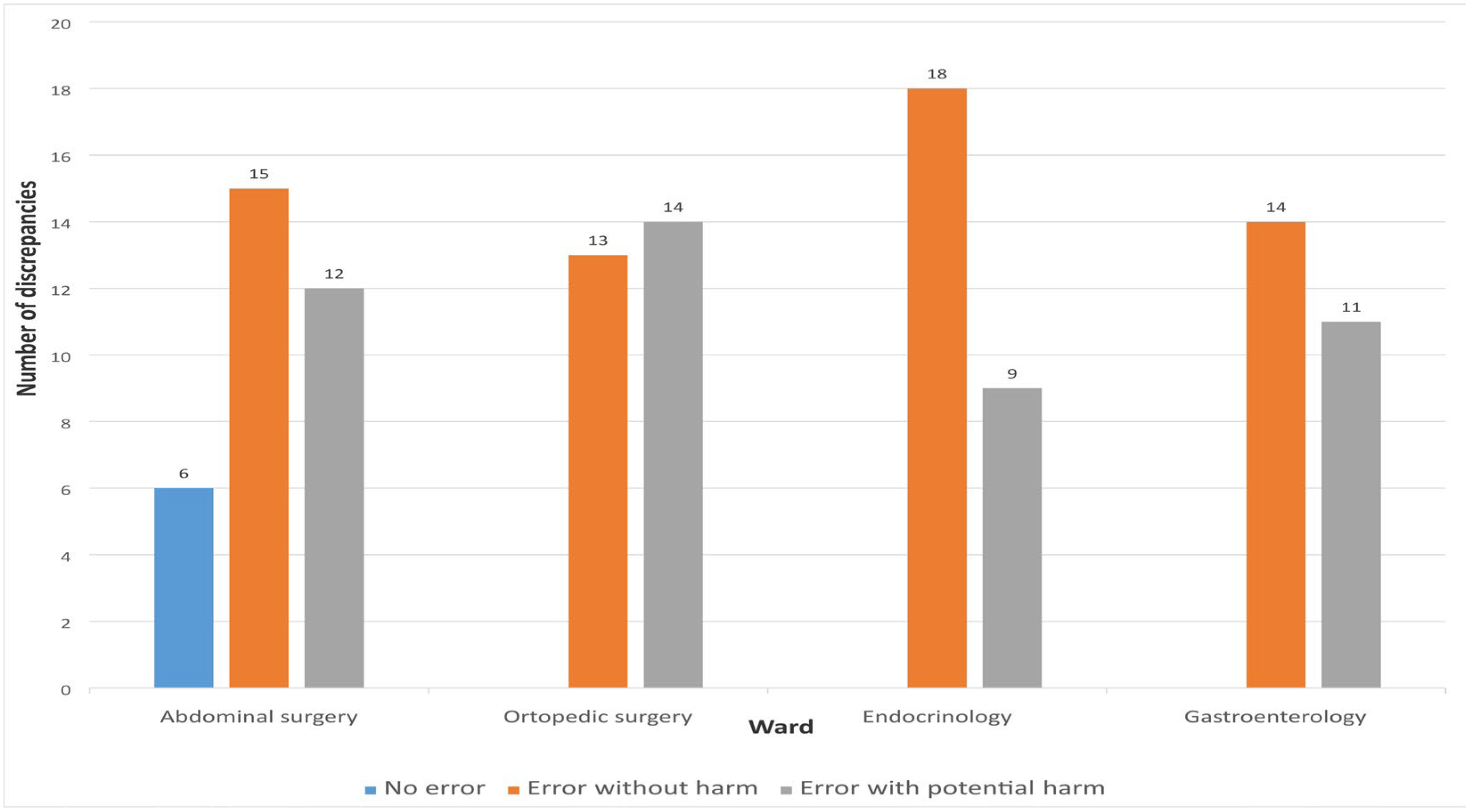The Role of the Clinical Pharmacist in Hospital Admission Medication Reconciliation in Low-Resource Settings
Abstract
1. Introduction
- Medication reconciliation
- Medication management
- Therapeutic drug monitoring (TDM)
- Patient education at discharge [19].
2. Materials and Methods
2.1. Study Design and Settings
2.2. Patients and Methods
- All pre-admission medications (name, dosage, pharmaceutical form, route of administration, dosing interval, duration, and indication);
- Over-the-counter (OTC) medications, herbal products, and dietary supplements;
- History of drug allergies and previously experienced ADRs;
- Medication adherence.
2.3. Outcomes
2.4. Statistical Analysis
3. Results
4. Discussion
5. Conclusions
Author Contributions
Funding
Institutional Review Board Statement
Informed Consent Statement
Data Availability Statement
Conflicts of Interest
References
- Sponsler, K.C.; Neal, E.B.; Kripalani, S. Improving medication safety during hospital-based transitions of care. Clevel. Clin. J. Med. 2015, 82, 351–360. [Google Scholar] [CrossRef] [PubMed]
- Abu Farha, R.; Yousef, A.; Gharaibeh, L.; Alkhalaileh, W.; Mukattash, T.; Alefishat, E. Medication discrepancies among hospitalized patients with hypertension: Assessment of prevalence and risk factors. BMC Health Serv. Res. 2021, 21, 1338. [Google Scholar] [CrossRef] [PubMed]
- Lester, P.E.; Sahansra, S.; Shen, M.; Becker, M.; Islam, S. Medication Reconciliation: An Educational Module. MedEdPORTAL 2019, 15, 10852. [Google Scholar] [CrossRef] [PubMed]
- Mazhar, F.; Akram, S.; Al-Osaimi, Y.A.; Haider, N. Medication reconciliation errors in a tertiary care hospital in Saudi Arabia: Admission discrepancies and risk factors. Pharm. Pract. 2017, 15, 864. [Google Scholar] [CrossRef]
- Barnsteiner, J.H. Medication Reconciliation: Transfer of medication information across settings-keeping it free from error. Am. J. Nurs. 2005, 105 (Suppl. 3), 31–36. [Google Scholar] [CrossRef]
- Cornish, P.L.; Knowles, S.R.; Marchesano, R.; Tam, V.; Shadowitz, S.; Juurlink, D.N.; Etchells, E.E. Unintended medication discrepancies at the time of hospital admission. Arch. Intern. Med. 2005, 165, 424–429. [Google Scholar] [CrossRef]
- AbuYassin, B.H.; Aljadhey, H.; Al-Sultan, M.; Al-Rashed, S.; Adam, M.; Bates, D.W. Accuracy of the medication history at admission to hospital in Saudi Arabia. Saudi Pharm. J. 2011, 19, 263–267. [Google Scholar] [CrossRef]
- Ceschi, A.; Noseda, R.; Pironi, M.; Lazzeri, N.; Eberhardt-Gianella, O.; Imelli, S.; Ghidossi, S.; Bruni, S.; Pagnamenta, A.; Ferrari, P. Effect of Medication Reconciliation at Hospital Admission on 30-Day Returns to Hospital: A Randomized Clinical Trial. JAMA Netw. Open 2021, 4, e2124672. [Google Scholar] [CrossRef]
- Pourrat, X.; Corneau, H.; Floch, S.; Kuzzay, M.P.; Favard, L.; Rosset, P.; Hay, N.; Grassin, J. Communication between community and hospital pharmacists: Impact on medication reconciliation at admission. Int. J. Clin. Pharm. 2013, 35, 656–663. [Google Scholar] [CrossRef]
- SHPA Practice Standards. SHPA Standards of Practice for Clinical Pharmacy. SHPA Committee of Specialty Practice in Clinical Pharmacy. J. Pharm. Pract. Res. 2005, 35, 122–146. [Google Scholar]
- Guo, Q.; Guo, H.; Song, J.; Yin, D.; Song, Y.; Wang, S.; Li, X.; Duan, J. The role of clinical pharmacist trainees in medication reconciliation process at hospital admission. Int. J. Clin. Pharm. 2020, 42, 796–804. [Google Scholar] [CrossRef]
- Dura’n-Garcı’a, E.; Fernandez-Llamazares, C.M.; Calleja-Herna’ndez, M.A. Medication reconciliation: Passing phase or real need? Int. J. Clin. Pharm. 2012, 34, 797–802. [Google Scholar] [CrossRef]
- Institute for Safe Medication Practices. Medicine Safety Tips: High-Alert Medicines. 2025. Available online: https://www.consumermedsafety.org/high-alert-medications (accessed on 3 March 2025).
- El Morabet, N.; Uitvlugt, E.B.; van den Bemt, B.J.F.; van den Bemt, P.M.L.A.; Janssen, M.J.A.; Karapinar-Çarkit, F. Prevalence and Preventability of Drug-Related Hospital Readmissions: A Systematic Review. J. Am. Geriatr. Soc. 2018, 66, 602–608. [Google Scholar] [CrossRef] [PubMed]
- Sarah, B.; Lea, D.; Manuel, H.; Adrian, D.; Aristomenis, E.; Stephan, K.; Evangelia, L. Retrospective analysis of adverse drug reactions leading to short-term emergency hospital readmission. Swiss Med. Wkly. 2021, 151, w20400. [Google Scholar]
- American Society of Health-System Pharmacists. ASHP guidelines on preventing medication errors in hospitals. Am. J. Health Syst. Pharm. 2018, 75, 1493–1517. [Google Scholar] [CrossRef] [PubMed]
- Doherty, A.S.; Shahid, F.; Moriarty, F.; Boland, F.; Clyne, B.; Dreischulte, T.; Fahey, T.; Kennelly, S.P.; Wallace, E. Prescribing cascades in community-dwelling adults: A systematic review. Pharmacol. Res. Perspect. 2022, 10, e01008. [Google Scholar] [CrossRef]
- National Coordinating Council for Medication Error Reporting and Prevention. About Medication Errors. NCC MERP Index for Categorizing Medication Errors. Available online: https://www.nccmerp.org/sites/default/files/index-color-2021-draft-change-10-2022.pdf (accessed on 5 March 2025).
- Urbańczyk, K.; Guntschnig, S.; Antoniadis, V.; Falamic, S.; Kovacevic, T.; Kurczewska-Michalak, M.; Miljković, B.; Olearova, A.; Sviestina, I.; Szucs, A.; et al. Recommendations for wider adoption of clinical pharmacy in Central and Eastern Europe in order to optimise pharmacotherapy and improve patient outcomes. Front. Pharmacol. 2023, 14, 1244151. [Google Scholar] [CrossRef]
- Bond, C.A.; Raehl, C.L.; Franke, T. Clinical pharmacy services, hospital pharmacy staffing, and medication errors in United States hospitals. Pharmacotherapy 2002, 22, 134–147. [Google Scholar] [CrossRef]
- Shaker, H.O.; Sabry, A.A.F.; Salah, A.; Ragab, G.M.; Sedik, N.A.; Ali, Z.; Magdy, D.; Alkafafy, A.M. The impact of clinical pharmacists’ medication reconciliation upon patients’ admission to reduce medication discrepancies in the emergency department: A prospective quasi-interventional study. Int. J. Emerg. Med. 2023, 16, 89. [Google Scholar] [CrossRef]
- Yamada, Y.; Kobayashi, R.; Yamamoto, T.; Fujii, H.; Iihara, H.; Hiroko, K.H.; Nishida, S.; Hoshino, R.; Niwa, T.; Kumada, K.; et al. Medication reconciliation by pharmacists for pre-admission patients improves patient safety. J. Pharm. Health Care Sci. 2024, 10, 19. [Google Scholar] [CrossRef]
- Marinović, I.; Marušić, S.; Mucalo, I.; Mesarić, J.; Bačić Vrca, V. Clinical pharmacist-led program on medication reconciliation implementation at hospital admission: Experience of a single university hospital in Croatia. Croat. Med. J. 2016, 57, 572–581. [Google Scholar] [CrossRef]
- Kovacevic, T.; Falade, J. Overcoming challenges: Implementing and scaling clinical pharmacy education and practice in the Republic of Srpska/Bosnia and Herzegovina. Int. J. Clin. Pharm. 2025. [Google Scholar] [CrossRef]
- IBM Corp. IBM SPSS Statistics for Windows, Version 26.0; IBM Corp.: Armonk, NY, USA, 2019.
- Abdulghani, K.H.; Aseeri, M.A.; Mahmoud, A.; Abulezz, R. The impact of pharmacist-led medication reconciliation during admission at tertiary care hospital. Int. J. Clin. Pharm. 2018, 40, 196–201. [Google Scholar] [CrossRef]
- Ling Oh, A.; Gerald, A.; Kiong Tan, H.; Yee Yew Chieng, I. Detection of Medication Errors through Medication History Assessment during Admission at General Medical Wards. J. Pharm. Pract. 2022, 35, 407–412. [Google Scholar]
- Marinović, I.; Samardžić, I.; Falamić, S.; Bačić Vrca, V. Pharmacotherapy Problems in Best Possible Medication History of Hospital Admission in the Elderly. Pharmacy 2022, 10, 136. [Google Scholar] [CrossRef] [PubMed]
- Gleason, K.M.; McDaniel, M.R.; Feinglass, J.; Baker, D.W.; Lindquist, L.; Liss, D.; Noskin, G.A. Results of the Medications at Transitions and Clinical Handoffs (MATCH) study: An analysis of medication reconciliation errors and risk factors at hospital admission. J. Gen. Intern. Med. 2010, 25, 441–447. [Google Scholar] [CrossRef]
- Breuker, C.; Macioce, V.; Mura, T.; Castet-Nicolas, A.; Audurier, Y.; Boegner, C.; Jalabert, A.; Villiet, M.; Avignon, A.; Sultan, A. Medication Errors at Hospital Admission and Discharge: Risk Factors and Impact of Medication Reconciliation Process to Improve Healthcare. J. Patient Saf. 2021, 17, e645–e652. [Google Scholar] [CrossRef] [PubMed]
- Pippins, J.R.; Gandhi, T.K.; Hamann, C.; Ndumele, C.D.; Labonville, S.A.; Diedrichsen, E.K.; Carty, M.G.; Karson, A.S.; Bhan, I.; Coley, C.M.; et al. Classifying and predicting errors of inpatient medication reconciliation. J. Gen. Intern. Med. 2008, 23, 1414–1422. [Google Scholar] [CrossRef] [PubMed]
- Gellad, W.F.; Grenard, J.L.; Marcum, Z.A. A systematic review of barriers to medication adherence in the elderly: Looking beyond cost and regimen complexity. Am. J. Geriatr. Pharmacother. 2011, 9, 11–23. [Google Scholar] [CrossRef]
- Unroe, K.T.; Pfeiffenberger, T.; Riegelhaupt, S.; Jastrzembski, J.; Lokhnygina, Y.; Colón-Emeric, C. Inpatient medication reconciliation at admission and discharge: A retrospective cohort study of age and other risk factors for medication discrepancies. Am. J. Geriatr. Pharmacother. 2010, 8, 115–126. [Google Scholar] [CrossRef]





| No Error | Category A | Circumstances or Events That Have the Capacity to Cause Error. |
|---|---|---|
| Error, No Harm | Category B | An error occurred but the error did not reach the patient (an “error of omission” does reach the patient). |
| Category C | An error occurred that reached the patient but did not cause patient harm. | |
| Category D | An error occurred that reached the patient and required monitoring to confirm that it resulted in no harm to the patient and/or required intervention to preclude harm. | |
| Error, Harm | Category E | An error occurred that may have contributed to or resulted in temporary harm to the patient and required intervention. |
| Category F | An error occurred that may have contributed to or resulted in temporary harm to the patient and required initial or prolonged hospitalization. | |
| Category G | An error occurred that may have contributed to or resulted in permanent patient harm. | |
| Category H | An error occurred that required intervention necessary to sustain life. | |
| Error, Death | Category I | An error occurred that may have contributed to or resulted in the patient’s death. |
| Characteristic | Value |
|---|---|
| Age, years, median (IQR) | 67 (58–72) |
| Sex, male, n (%) | 20 (30.8) |
| BMI, kg/m2, mean (SD) | 25.8 (±6.2) |
| Organizing medicines at home | |
| Alone, n (%) | 54 (83.1) |
| Family, n (%) | 7 (10.8) |
| Guardian, n, (%) | 4 (6.2) |
| Admission to hospital | |
| Urgent, n (%) | 35 (53.8) |
| Non-urgent, n (%) | 30 (46.2) |
| Internal medicine wards, n (%) | 33 (50.8) |
| Endocrinology, n (%) | 23 (35.4) |
| Gastroenterology, n (%) | 10 (15.4) |
| Surgical wards, n (%) | 32 (49.2) |
| Abdominal surgery, n (%) | 20 (30.8) |
| Orthopedic surgery, n (%) | 12 (18.5) |
| Physician | Pharmacist | p-Value 1 | |
|---|---|---|---|
| Number of recorded drugs, median (IQR) | 2 (1–4) | 5 (3–7) | <0.01 |
| <65 Years, n = 25 | ≥65 Years, n = 40 | p-Value 1 | |
|---|---|---|---|
| Number of discrepancies, median (IQR) | 1 (0–2.5) | 2 (1–3.75) | 0.035 |
| Urgent, n = 35 | Scheduled, n = 30 | p-Value 1 | |
|---|---|---|---|
| Number of discrepancies, median (IQR) | 2 (1–3) | 1 (0–3) | 0.877 |
| ATC Class of Medicines | Medicines, n (%) |
|---|---|
| A Medicines that affect the alimentary tract and metabolism | 21 (18.77) |
| B Medicines with effects on blood and blood organs | 2 (1.75) |
| C Medicines that affect the cardiovascular system | 37 (33.05) |
| G Medicines that affect genitourinary system | 3 (2.69) |
| M Medicines that affect the musculoskeletal system | 5 (4.47) |
| N Medicines that affect the nervous system | 16 (14.29) |
| R Medicines that affect the respiratory system | 3 (2.67) |
| OTC drugs | 25 (22.33) |
Disclaimer/Publisher’s Note: The statements, opinions and data contained in all publications are solely those of the individual author(s) and contributor(s) and not of MDPI and/or the editor(s). MDPI and/or the editor(s) disclaim responsibility for any injury to people or property resulting from any ideas, methods, instructions or products referred to in the content. |
© 2025 by the authors. Licensee MDPI, Basel, Switzerland. This article is an open access article distributed under the terms and conditions of the Creative Commons Attribution (CC BY) license (https://creativecommons.org/licenses/by/4.0/).
Share and Cite
Kovačević, T.; Nedinić, S.; Barišić, V.; Miljković, B.; Fazlić, E.; Vukadinović, S.; Kovačević, P. The Role of the Clinical Pharmacist in Hospital Admission Medication Reconciliation in Low-Resource Settings. Pharmacy 2025, 13, 107. https://doi.org/10.3390/pharmacy13040107
Kovačević T, Nedinić S, Barišić V, Miljković B, Fazlić E, Vukadinović S, Kovačević P. The Role of the Clinical Pharmacist in Hospital Admission Medication Reconciliation in Low-Resource Settings. Pharmacy. 2025; 13(4):107. https://doi.org/10.3390/pharmacy13040107
Chicago/Turabian StyleKovačević, Tijana, Sonja Nedinić, Vedrana Barišić, Branislava Miljković, Emir Fazlić, Slobodan Vukadinović, and Pedja Kovačević. 2025. "The Role of the Clinical Pharmacist in Hospital Admission Medication Reconciliation in Low-Resource Settings" Pharmacy 13, no. 4: 107. https://doi.org/10.3390/pharmacy13040107
APA StyleKovačević, T., Nedinić, S., Barišić, V., Miljković, B., Fazlić, E., Vukadinović, S., & Kovačević, P. (2025). The Role of the Clinical Pharmacist in Hospital Admission Medication Reconciliation in Low-Resource Settings. Pharmacy, 13(4), 107. https://doi.org/10.3390/pharmacy13040107








